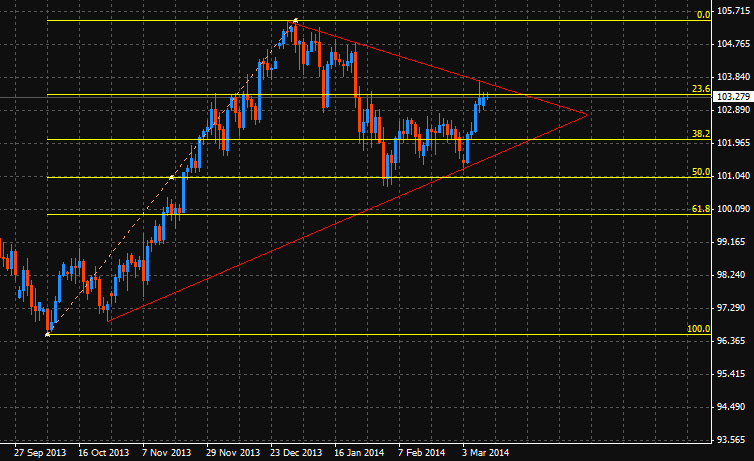FXOpen
Japanese Yen (JPY) strengthened against US Dollar (USD) on Tuesday as the Bank of Japan (BoJ) kept the monetary policy unchanged. The pair is poised for a breakout through the rising wedge formation because the wedge has been too squeezed now; the breakout will provide clear direction to the pair.
As of this writing, the pair is being traded around 103.27 with immediate resistance seen near 103.35 that is the 23.6% fib level ahead of 103.65 which is the trendline resistance. A daily close above the trendline resistance could push USD/JPY into considerably stronger bullish momentum, hence exposing 104.10 and 104.50.
On downside, the pair is expected to find support near 102.00 handle i.e. the psychological level and the 38.2% fib level ahead of 101.50 that is the channel support as shown in the above chart. A daily close below the channel shall open doors for further downside movement towards 101.200 and 100.50.
The technical indicator, Commodity Channel Index (CCI), is retreating from the extreme overbought territory with 160 reading on the daily chart. A CCI reading above 100 indicates overbought bias among traders.
Meanwhile, the Bank of Japan (BoJ) kept the benchmark interest rate unchanged at 0.1%. The central bank also pledged to continue the record quantitative easing at its current pace of $60 trillion to $70 trillion every year, the decisions were broadly in line with the median projection of different economists.
The International Monetary Fund (IMF) has predicted that the total debt of Japan could be equal to around 242% of the total size of the economy by the end of the ongoing year.
It is pertinent that the economy is also likely to shrink by 3.9% during the course of three months from April, according to the forecast of various analysts surveyed by Bloomberg. The Asian nation had posted the downbeat growth report for the previous quarter, showing the lack of foreign investment and exports.
Trade over 50 forex markets 24 hours a day with FXOpen. Take advantage of low commissions, deep liquidity, and spreads from 0.0 pips. Open your FXOpen account now or learn more about trading forex with FXOpen.
This article represents the opinion of the Companies operating under the FXOpen brand only. It is not to be construed as an offer, solicitation, or recommendation with respect to products and services provided by the Companies operating under the FXOpen brand, nor is it to be considered financial advice.
Stay ahead of the market!
Subscribe now to our mailing list and receive the latest market news and insights delivered directly to your inbox.









